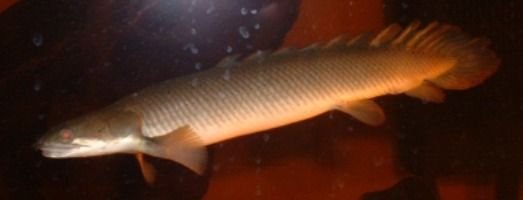Common name/s:Senegal bichir, Cuviers bichir, Grey bichir, Dinosaur eel
Scientific name:Polypterus senegalus senegalus
Family:Polypteridae
Origin:Widespread across tropical Africa
Maximum size:12" to 20", usually smaller.
Care: The fish has no special needs for water parameters, as long as extreems of hardness and pH are avoided the fish will thrive, keep the temperature between 25 and 28 centigrade (77-82f). Minimum tank size should be 30g. Decorate the tank with rocks and bogwood, as with all bichirs a sand substrate is recomended to prevent the fish from accidently swallowing gravel when feeding. The fish is a predator so tankmates should be at least half its size.
Feeding:Live and frozen meaty foods of all kinds, fish are a favourite. Small specimins can be fed bloodworms until they have grown enough to take larger foods.
Sexing: Males have a large pocket like anal fin.
Breeding: Rare but possible, the fish are egg scatterers and show no brood care.
Comments: As the fish rarely grows larger than 10" this is one of the more easily kept bichirs, they are also not as nocturnal as other bichir species and will happily feed and move about in daylight.
Scientific name:Polypterus senegalus senegalus
Family:Polypteridae
Origin:Widespread across tropical Africa
Maximum size:12" to 20", usually smaller.
Care: The fish has no special needs for water parameters, as long as extreems of hardness and pH are avoided the fish will thrive, keep the temperature between 25 and 28 centigrade (77-82f). Minimum tank size should be 30g. Decorate the tank with rocks and bogwood, as with all bichirs a sand substrate is recomended to prevent the fish from accidently swallowing gravel when feeding. The fish is a predator so tankmates should be at least half its size.
Feeding:Live and frozen meaty foods of all kinds, fish are a favourite. Small specimins can be fed bloodworms until they have grown enough to take larger foods.
Sexing: Males have a large pocket like anal fin.
Breeding: Rare but possible, the fish are egg scatterers and show no brood care.
Comments: As the fish rarely grows larger than 10" this is one of the more easily kept bichirs, they are also not as nocturnal as other bichir species and will happily feed and move about in daylight.










 Beefheart, fresh fish from the local market, live earthworms (I cut them up, but they still wiggle lol).
Beefheart, fresh fish from the local market, live earthworms (I cut them up, but they still wiggle lol).
